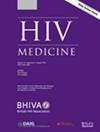Immune profiles and HIV reservoir in people switching to long-acting cabotegravir/rilpivirine: Findings from a real-life prospective study
Abstract
Introduction
Data on the dynamics of HIV-DNA and immune profiles under treatment with long-acting cabotegravir and rilpivirine (LACR) are limited.
Methods
We prospectively enrolled people living with HIV who initiated LACR in our centre and assessed changes in HIV-DNA levels (measured by digital droplet PCR), as well as immune activated, senescent, exhausted, and regulatory T and B cells (analysed by flow cytometry), in peripheral blood mononuclear cells (PBMC) from baseline (T0) to 48 weeks of treatment (T5). Bivariate analyses, one-way repeated measures ANOVA and mixed ANOVA were conducted to assess differences in characteristics and biomarker changes over time between individuals switching to LACR from a dual (Group A) or triple (Group B) antiretroviral regimen.
Results
A total of 71 persons were included (77.5% males, median age of 48 years). Overall, HIV-DNA levels exhibited a slight non-significant decrease, whereas activated CD8 cells decreased significantly (p < 0.001). Proportions of activated CD4 and regulatory T cells showed strong negative trends, but decreases did not reach statistical significance (p = 0.002 and 0.005). The dynamics of these markers within the two subgroups mirrored those of the entire cohort, with some differences. At baseline, Group A tended to exhibit higher levels of HIV-DNA (96 [31–160] vs. 41 [6–93] copies/106 PBMC, p = 0.088), and activated CD4 (% activated CD4 cells: 2.3 [1–2.9] vs. 1 [0.7–2], p = 0.154) and CD8 cells (% activated CD8 cells: 4.9 [2.2–5.8] vs. 2.2 [1.2–3.5], p = 0.023) than Group B. Over the 48-week treatment period, HIV-DNA levels decreased slightly in both groups, remaining higher in Group A. At the end of the 48-week treatment period, the decrease of activated CD4 and CD8 cells was more pronounced in Group A than in Group B, ultimately reaching comparable levels between the two groups (% of activated CD4 cells: 0.9 [0.6–1.9] vs. 0.7 [0.6–1.1], p = 0.502): % of CD8 activated cells: (2 [1.3–2.5] vs. 1.6 [0.9–2.2], p = 0.278).
Conclusion
During the first year of treatment, LACR does not significantly impact the HIV reservoir. However, it may reduce immune activation, particularly in persons switching from a dual therapy regimen.

 求助内容:
求助内容: 应助结果提醒方式:
应助结果提醒方式:


